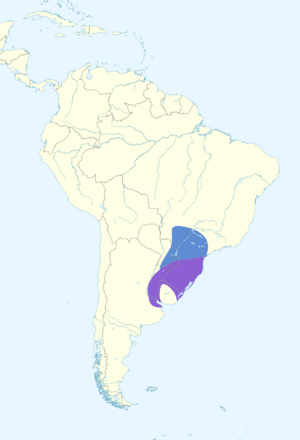Glaucous-blue grosbeak facts for kids
Quick facts for kids Glaucous-blue grosbeak |
|
|---|---|
 |
|
| male at Iporanga, São Paulo State, Brazil | |
| Conservation status | |
| Scientific classification | |
| Genus: |
Cyanoloxia
|
| Species: |
glaucocaerulea
|
 |
|
| Non-breeding
Year-round |
|
| Synonyms | |
|
Passerina glaucocaerulea (D'Orbigny & Lafresnaye, 1837) |
|
The glaucous-blue grosbeak (Cyanoloxia glaucocaerulea) is a beautiful bird. It is also known as the indigo grosbeak. This bird is part of the Cardinalidae family, which includes cardinals and other grosbeaks. You can find it living in Brazil, Argentina, Paraguay, and Uruguay.
Contents
About the Glaucous-Blue Grosbeak
The glaucous-blue grosbeak is a unique bird. It is the only species in its group that has always been called Cyanoloxia glaucocaerulea.
Scientists sometimes change how they group birds as they learn more. For a long time, this bird was the only one in its scientific group, called Cyanoloxia. Later, other similar birds, like the blue-black grosbeak and the ultramarine grosbeak, were moved into the Cyanoloxia group too.
What the Glaucous-Blue Grosbeak Looks Like
The glaucous-blue grosbeak is about 14 cm (5.5 in) long. That's about the length of a small ruler. These birds usually weigh between 16 to 19.5 g (0.56 to 0.69 oz).
The male glaucous-blue grosbeak is a striking dark sky blue color. Its forehead and back are a bit lighter blue. It also has a small black "mask" around its eyes. The lower part of its belly is grayish.
Female glaucous-blue grosbeaks are different. They are mostly brown, with darker and warmer brown colors on their back. Their underside has a hint of orange. Young birds are orange-brown and darker on their back. They might have a little blue color on their forehead and cheeks.
Where the Glaucous-Blue Grosbeak Lives
The glaucous-blue grosbeak makes its nests in northeastern Argentina, southeastern Brazil, and most of Uruguay. When winter comes in the southern hemisphere, some of these birds travel. They move into southeastern Paraguay and further north in Brazil.
These birds like to live in places with low, somewhat thick plants. You can find them along the edges of forests, on islands in rivers, in marshy areas, and in new forests that are growing back. They live from areas near the sea all the way up to 1,700 m (5,600 ft) high in Brazil.
Glaucous-Blue Grosbeak Behavior
How the Glaucous-Blue Grosbeak Finds Food
Glaucous-blue grosbeaks are known to look for food in pairs. However, scientists don't know much about what they eat or how they find their food. More research is needed to learn about their diet.
Glaucous-Blue Grosbeak Reproduction
We only have information about how the glaucous-blue grosbeak breeds in Uruguay. There, they build their nests and lay eggs from October to December.
They build a cup-shaped nest using small twigs. They place these nests in thick plants to keep them safe. A female glaucous-blue grosbeak usually lays two to four eggs.
What the Glaucous-Blue Grosbeak Sounds Like
The glaucous-blue grosbeak often sings from hidden spots in thick plants. Its song is described as a "fast, high, hurried jumbled warbling" [1]. When it makes a call, it sounds like "psit" or "jit" [2].
Status of the Glaucous-Blue Grosbeak
The IUCN (International Union for Conservation of Nature) has looked at the glaucous-blue grosbeak. They have listed it as a species of "Least Concern." This means that, for now, it is not considered to be in danger of disappearing.
However, this bird is generally quite rare or uncommon in many parts of its home range. Scientists also say that not much is known about this species.


